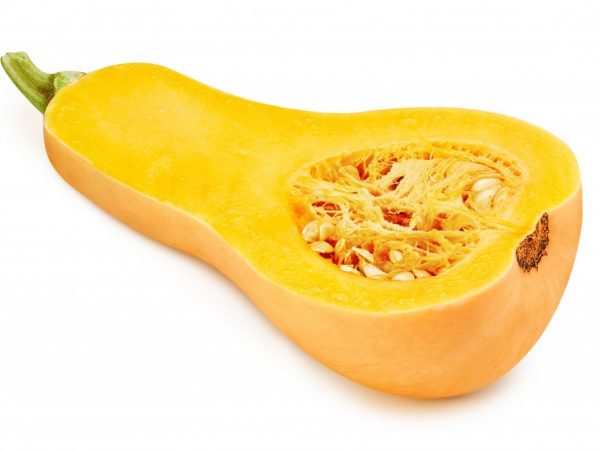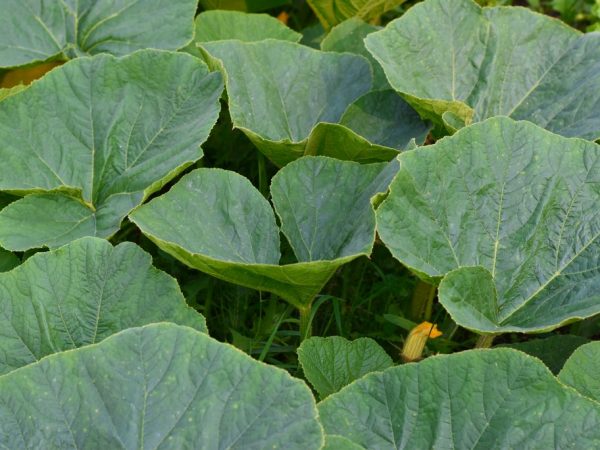Varietal features of butternut pumpkin Pearl
The fruits of melons and gourds are highly valued for the large amount of medicinal substances included in the composition and for their pleasant taste. One of the most fragrant, tasty and healthy is the butternut pearl pumpkin. So that she does not lose her taste, it is important to observe the correct conditions for her cultivation.

Varietal features of butternut pumpkin Pearl
Characteristics of the variety
Mid-late plant: between planting seeds in the ground and harvesting, at least 100-110 days should pass, and sometimes it is necessary to wait up to 130 days for full ripeness. Short, powerful, it has 4 to 7 lateral lashes.
Description of pumpkin Pearl.
- The form. Most often, it is elongated-cylindrical, sometimes round, oval, ribbed fruits come across. Especially appreciated is the pear-shaped form, which has a thickening in the upper part. A small seed nest is located in it, and the rest of the vegetable is a pulp, which significantly increases the size of the edible component of the product.
- Size and weight. Pumpkins of this variety are large: their average length is from 45 to 50 cm. Weight - 5-8 kg.
- Color. The peel of the plant gradually changes its color from gray-green to orange-greenish. The pulp, due to the keratin, has a bright reddish-orange color.
- Skin. Slim, flexible.
- Pulp. It has a fibrous structure, juicy, soft, crunchy, dense, located in a thick layer. Delicate, pleasant to the taste. It is part of many culinary dishes.
- Leaves. They are of medium size, pentagonal, unbroken. Dark green with minor white spots.
The main characteristics of this type of pumpkin are:
- resistance to low temperatures;
- high yield rate;
- good drought tolerance;
- long shelf life.
Harvest in clear, dry weather, trying not to break the tail at the root - it should be 5 to 10 cm in length. If possible, the plucked fruits are kept in the sun for about 3-4 days.
Advice: do not store the pumpkin in the cellar, basement - there it will quickly mold and rot. Try to eat it within six months, as after that the vegetable loses its taste.
Growing rules
To obtain a quality harvest, it is important to adhere to certain principles. The quantity and taste of the fruits removed directly depends on this.
Conditions
An important condition in the process of growing this melon crop is a correctly selected land plot. It should be:
- well lit by the sun, quickly warming up;
- protected from drafts;
- with sandy loam or loamy soil.
Growing nutmeg fruits does not require much effort, high time and material costs. For this reason, even inexperienced gardeners can cultivate them.
Seed preparation

Seeds for planting must be prepared
Before planting seeds, they need to be prepared. For this purpose it is necessary:
- soak them for 18-20 hours in an aqueous solution of potassium permanganate at the rate of 500 mg per 1 liter of water;
- after the specified time, rinse the planting material with clean water;
- dry the seeds well;
- treat them with a contact action fungicide (this will help protect the plant from various diseases).
Seed preparation is carried out shortly before planting.
Garden bed preparation
To plant a pumpkin, you need to prepare the beds. To do this, dig holes, leaving a distance of about 1 to 1.4 m between them.Place the beds so that the distance between them is about 1 m 40 cm.
Planting seeds
Planting seeds can be done in two ways:
- directly into the ground;
- for seedlings.
Plant seeds in the ground in the last days of May - early June. For seedlings, sow them in April. It is advisable to put 2 seeds in the hole to a depth of about 5 cm.
Thin out the appeared sprouts. With proper sowing of planting material, you can harvest up to 15 kg from 1 sq. m.
Info: Pumpkin grows most vigorously at temperatures between 18 and 25 ° C.
Plant care
In order for the young shoots of the nutmeg plant to grow well, they need careful care. If the summer season is accompanied by cold weather, cut the stems, leaving no more than three pieces.
When the sprout reaches a height of 50 cm, cut off the top. This will give the opportunity to develop lateral processes.
Watering

It is important to water the plants regularly during flowering.
Although the Pearl pumpkin tolerates dry periods well, it is a fairly moisture-loving plant. Water it under the roots about once a week. The most important points when a plant needs watering are:
- period of active formation of inflorescences;
- flowering time;
- fruit setting stage.
At the end of the stage of ovary formation, the frequency and intensity of watering must be reduced to 1 time in 2 weeks. Otherwise, there is a risk of a decrease in the palatability of pumpkins due to excess moisture, as well as the likelihood of cracking.
Root development
For the development of the vegetative part, on which the fruits are formed, sprinkle the branching internodes with pre-moistened soil. This procedure will lead to the appearance of more adventitious roots. The powder must be done 2-3 times per season.
Top dressing
Pumpkin Pearl has a good reaction to feeding. The very first is produced at planting, adding organic fertilizer and humus to each well in a ratio of 2 tbsp. l. 5 kg.
In the first 2 summer months, feeding is done every 2 weeks, combining:
- cow dung solution - 1: 5;
- complex mineral fertilizers - 1 tbsp. l.
In the last summer month, they switch to potash fertilizers.
Information: when planting a nutmeg melon crop near the compost pit, the yield increases several times.
Pollination
For normal pollination, it is necessary to comply with:
- humidity level;
- temperature conditions.
The optimum is the average moisture content - from 60 to 70%. The temperature must be above 20 ° C.
Diseases and pests
The most common and most dangerous for the Pearl pumpkin variety are the following diseases and pests:
- bacteriosis. It is the appearance of brown dots on the seed lobes, which gradually degenerate into ulcers. The plant affected by the disease is subject to complete destruction with disinfection of the growth site and neighboring pumpkins with Bordeaux liquid or copper sulfate;
- root rot is a fungal infection of the roots and stems, leading to a cessation of fruit development. They fight the disease by watering the roots with a solution of previcur and adding top dressing in the form of copper sulfate and zinc sulfate (1: 1). To form new roots, the plant is sprinkled with soil;
- powdery mildew is a resistant fungus that appears due to an excess of moisture, low temperatures, and an excessive amount of nitrogenous fertilizers. Medicine: sodium hydrogen phosphate, cumulus;
- spider mite is a pest that appears on leaves during dry periods. Afraid of moisture, eliminated with isophene solution, ground sulfur;
- melon aphid - a pest that settles on the underside of leaves. You can get rid of it by spraying with karbofos.
The surest way to prevent the appearance of diseases and pests is to periodically weed the beds from weeds, remove infected plants, and do not overdo it with watering.

